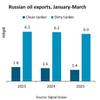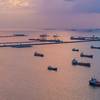Nordic American Tanker Shipping Q3 Report
On or about December 4, Nordic American Tanker Shipping (NAT) will pay a dividend for the 49th consecutive quarter since the first three vessels were delivered to the company in the autumn of 1997 when the company commenced operations. Since then a total of $39.89 per share has been paid in dividend.
The low spot rates for suezmax tankers during 3Q09 resulted in a lower dividend payment than in the 2Q09. In this environment, with a spot market fleet, except for one vessel, the Company can be expected to reap the benefits of a potential upswing in the tanker market more or less immediately. The Imarex rates, giving an indication of the level of the tanker market, were on average $13,000 per day during 3Q09. The Imarex rate for suezmaxes at the time of this report is $17,846 per day. The average Imarex projected rates for November and December are about $20,000 per day. It is indicated that the world economy, as expressed by the GNP development, has bottomed out which is positive for the tanker business. The Board is optimistic for the future of the company and the announcement to acquire vessel no. 18 is a confirmation of this view.
During 2009 NAT has acquired three vessels, and has entered into an agreement to acquire the fourth, increasing the trading fleet by one third - from 12 to 16 vessels - since the beginning of the year. The acquisitions are accretive, increasing the dividend potential of the company. The acquisitions have improved our position relative to competitors which have a tough time in coping with the consequences of the international financial crisis. The company has two newbuildings coming next year, bringing the trading fleet to 18 vessels. The company does not plan to go to the market to raise capital for the vessels the company now has, the one to be delivered to us by end February 2010 and the two newbuildings. From the end of 2008 and until August 2010 - a period of 20 months - the total fleet will have grown from 12 to 18 vessels, thereby increasing the dividend and earnings potential by 50%.
A full dividend payout policy and a strong balance sheet are central components of the consistent and transparent strategy of NAT. As in the past, in order to create value for shareholders, the fleet must grow faster than the share count over time.
Typically, the company’s dividend follows the level of the spot suezmax tanker freight market. That is why the dividend is lower in 3Q09 than in 2Q09. However, the company’s policy of paying dividends from operating cash flow remains the same. Generally, when rates in the suezmax freight market increase, the company’s dividend can be expected to increase. Therefore, the company has the full upside associated with a market improvement. Going forward, we expect that spot suezmax freight rates may fluctuate in an unpredictable manner.
The present instability in the financial markets and the lower freight markets are posing serious issues for debt laden shipping companies. Some of them have suspended dividends or changed their dividend policy and they have had to negotiate new terms with the banks. NAT is staying its course in this environment - having no net debt. We go forward with a view to retaining what we consider the exceptionally strong financial situation of the company - both in absolute and relative terms - as we believe that is in the best interests of our shareholders.
The company’s primary objective is to maximize total return to shareholders, including maximizing quarterly cash dividend. The company does not engage in any type of derivatives.
Financial Information:
The Board has declared a dividend of $0.10 per share in respect of 3Q09. A dividend of $0.50 per share was declared for 2Q09. The amount of dividends per share is above all a reflection of the level of the spot tanker market during the relevant quarter and the number of shares outstanding. The number of shares outstanding for the third quarter of 2009 was 42,204,904 - the same number as of the date of this release.
Net income for 3Q09 was -$11.8m, or -$0.28 per share (EPS) compared to net income of -$0.1m, or $0.00 per share for 2Q09. One-time charges and non-cash general and administrative items for 3Q09 equal $0.02 and $0.03 per share, respectively. Therefore, result from ongoing operations was -$0.26 per share. Reflecting a weak spot market in the quarter, the Company's operating cash flow was $3.8m for 3Q09, compared to $17.0m for 2Q09.
The estimated average cash breakeven level for the company fleet is below $10,000 per day per vessel. When the freight market is above this level, the company can be expected to pay a dividend. The breakeven rate is the amount of average daily revenues our vessels would need to earn in the spot market in order to cover our vessel operating expenses, voyage expenses, if any, cash general and administrative expenses, interest expense and other financial charges.
At the time of this report the company has no net debt and has an undrawn revolving credit facility of $500 million. The credit facility, which matures in September 2013, is not subject to reduction by the lenders and there is no obligation to repay principal during the term of the facility. The company pays interest only on drawn amounts and a commitment fee for undrawn amounts. Assuming no more acquisitions are made until the last of the two newbuildings are delivered in 2010, the Company can be expected to have net debt of about $8 million per vessel at that time in addition to having a substantial reserve in the unused credit facility.
The double hull Suezmax tanker which was delivered to the Company on July 7, 2009, the Nordic Grace, was financed from cash on hand. The vessel we agreed to purchase on October 5, 2009, will also be financed from cash. The same goes for the vessel that the Company has agreed to acquire and which will be delivered to us by the end of February 2010.
For further details on our financial position and for other periods such as 3Q08 and for the nine months ended September 30, 2009 and September 30, 2008, please see later in this release.
The Fleet:
With the delivery of the Nordic Grace in July, the recently acquired vessel to be delivered by mid-November this year and the vessel expected to be delivered to us by end February 2010, 15 of the company's 16 existing vessels have employment in two cooperative arrangements. One vessel remains employed on a long-term fixed rate charter.
By way of comparison, in the autumn of 2004 the company had three vessels; at the end of 2005 the Company had eight vessels; and at the end of 2006 the company had 12 vessels. During 2Q09, we had 13 vessels in operation. With the two newbuildings announced in November 2007 and the most recent acquisitions, the company is expected to have a fleet of 18 vessels operating from August 2010, assuming no further acquisitions in the meantime.
No scheduled dry-dockings were undertaken during 3Q09. There are no further scheduled dry-dockings for vessels until 2010 when one dry-docking is expected to take place. During 3Q09, the company had in total 25 days of unplanned off-hire and 15 days planned off-hire for our fleet.
Financial Instability and the Tanker Market:
In the company’s quarterly reports to shareholders we have often stressed the significance of the development of the world economy for the tanker industry. Presently, the world economy shows a significant contraction of demand. This downturn influenced the suezmax tanker market during the 3Q09. Exports of oil from OPEC to the West have declined over the last few months, reducing demand for tanker vessels.
For NAT a lower freight tanker market can be expected to result in a lower dividend. If a lower freight market results in lower vessel prices - such a development would be an advantage for the company because it would be in a position to acquire additional vessels inexpensively compared to historic levels. The four acquisitions so far in 2009 reflect the ability of the company to grow accretively; they will allow the company to pay a higher dividend than if they had not taken place. This is so irrespective of the level of the suezmax spot tanker market, as long as the freight level is above the company's low cash break-even for its fleet as a whole.
While the recession internationally is reducing the demand for transportation capacity, the demand side for tankers to some extent continues to be impacted positively by the use of tankers for storage.
On the supply side, the company now sees clearly that the current financial upheaval may delay deliveries of newbuildings and may also lead to the cancellation of newbuilding orders.
The average daily rate for spot vessels was $14,075 per day net to the company during 3Q09 compared with $26,300 per day for 2Q09.
Spot market rates for suezmax tankers are very volatile. The average spot market rate for modern suezmax tankers as reported by Imarex was $13,012 per day in 3Q09 compared to $20,569 per day during 2Q09. The Imarex rate at the time of this report is $17,846 per day.
The graph shows the average yearly spot rates since 2000 as reported by R.S. Platou Economic Research a.s. The rates as reported by shipbrokers and by Imarex may vary from the actual rates we achieve in the market.
The company believes it is an advantage to have its spot vessels in two cooperative arrangements which in total have more than 50 suezmax vessels under commercial management.










